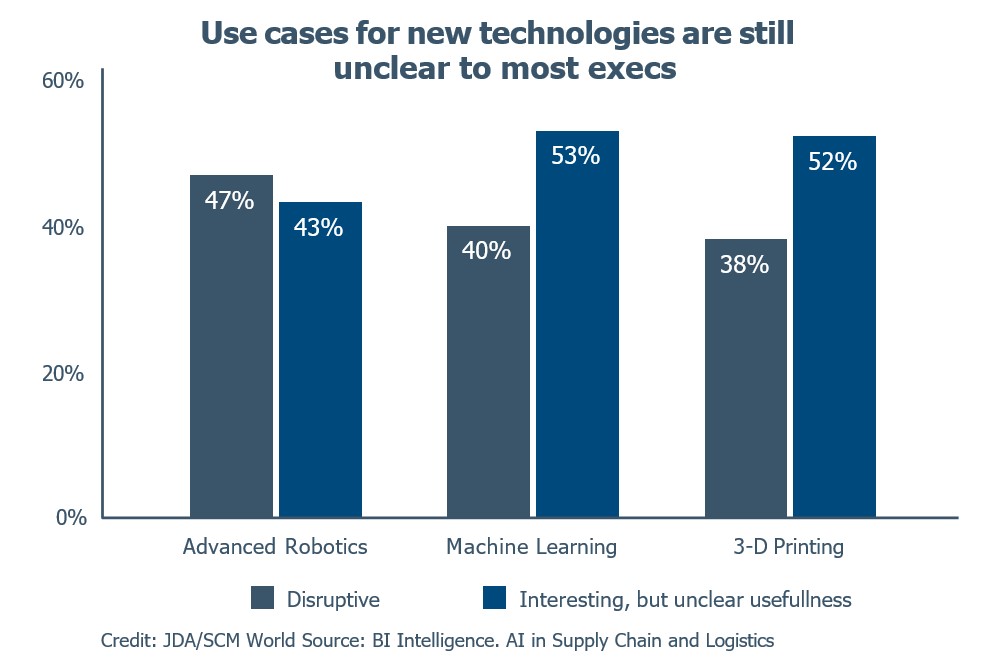Digital Supply Chain: You Need to Change. But How?
What’s all the fuss about?
Warren Buffett, promoted the term “economic moat.” This relates to a company’s ability to maintain an advantage over its competitors (through process, technology innovation and intellectual property) in order to protect its long-term profits and market share. With data analytics, Big Data, the Internet of Things (IoT), the smart factory, machine learning, predictive maintenance and Blockchain all turning from vision to reality, your competitors are building their ‘moats’ now.
Today IoT devices and disruptive technologies are being deployed throughout all areas of the supply chain. GSK is starting to leverage Blockchain, cryptographic security and smart contracts to provide verifiable insights as assets are managed and
propagated through the entire supply chain. In 2017, Wal-Mart tested a new traceability program using Blockchain technology, with positive results. The supermarket giant tracked pork in China and mangoes in the US, establishing a digital history for each product.
Formula 1 motor racing company McLaren plans to start 3D-printing parts for its F1 cars trackside at Grand Prix competitions around the world. The firm believes the technology and supply chain approach will give it an advantage over rivals allowing it to make last-minute changes. From manufacturing goods to medical implants and even food, 3D printing technology is set to have a deep and permanent impact on the supply chain.
Data analytics is at the forefront of supply chain management right now, given its power to demonstrably impact competitive advantage. For example, one of the world’s leading crop nutrients providers needed to improve competitiveness and assess the cost benefit and rail routing options of 48 potential origin-destination route options in North America. The insights and implementation support our supply chain and data analytics experts provided helped senior executives select and establish the optimal location for their new $50M North American distribution operation. Consequently, the company was able to get products to market five days faster than its competitors. This competitive advantage (‘moat’) resulted in a 7% increase in the company’s market share year-over-year in four consecutive years. At the same time, our team helped reduce the company’s rail fleet by 50%. This saved $48M in freight rate and fleet savings, while releasing over $500M in inventory and working capital for the business.
If you don’t currently have this sort of visibility into your operations, data aggregation and dashboard visualization (using your existing system’s data) is critical to get actionable insights, fast.
Tightly connected to data analytics is the advancement in predictive maintenance and artificial intelligence. With manufacturing operations destined to become increasingly autonomous, predictive maintenance (using machine learning to perform condition monitoring and prognostic analysis) is set to revolutionize the way operations are managed and maintained. This involves sensors being deployed all over the factory, providing real-time data on the status of production and machinery performance. By reducing unplanned machine down time by as much as 30-50% and increasing Overall Equipment Effectiveness (OEE), companies are set to increase the productivity of maintenance staff by 45-55% and reduce maintenance cost by 10-40%.
According to the Interactive Data Corporation (IDC), by 2020 approximately 80% of supply chain interactions will happen across cloud-based commerce networks. “Manufacturers of every size and shape are changing rapidly because of new digital technologies, new competitors, new ecosystems, and new ways of doing business,” says Kimberly Knickle, research vice president, IT priorities and strategies with analyst firm IDC Manufacturing Insights. “Manufacturers that can speed their adoption of digital capabilities in order to create business value will be the leaders of their industry.”
How to change? A pragmatic step-by-step approach
It’s a well-known fact that if things are complicated to do, they often don’t get done. This is supported by research from the Global Supply Chain Institute (GSCI). Its latest report finds that increasing complexity across the supply chain and cost-
savings fatigue is driving the need for a new approach to achieving competitive advantage (‘building the moat’). Disturbingly, they found that many companies were deprioritizing these initiatives because their value is hard to define and implement.
That’s why a pragmatic step-by-step approach to digital supply chain transformation is needed. Total Value Optimization (TVO), featured in the GSCI’s research, helps CEOs and supply chain leaders quantify and deliver the benefit of driving cross- functional collaboration across procurement, logistics, and operations functions. This proven approach helps companies break down functional silos, drive change and implement measurable value across the end-to-end digital supply chain.
TVO starts with an in-depth analysis across the entire supply chain to validate the total value creation opportunity, given most executives are struggling to quantify the benefits for change (see graph below). It Includes development of the quantifiable business case supported by a clear, measurable action plan / journey map for execution.

Following the analysis and buy-in from the CEO and supply chain leader, a step-by-step digital supply chain transformation journey can begin, driving self-funding operational momentum along the way. Aligning leader and operational teams with strategic goals, enhancing internal and external teams/processes and behaviors to deliver sustainable improvements are some of the keys to successful implementation.

